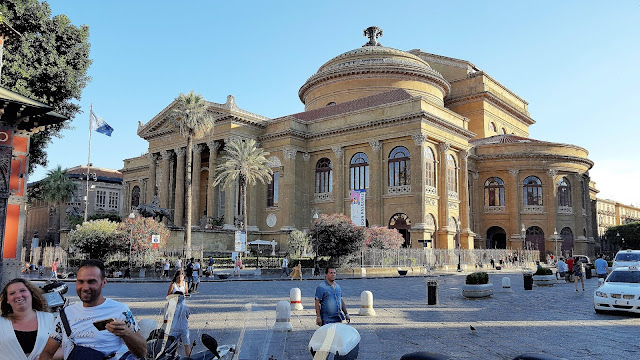Palermo was our last stop after three months in Italy. From there we returned to Rome for two nights and then flew home. After a relatively short and pleasant drive from Marsala, we arrived in Palermo, dropped our luggage at our hotel, Palco Rooms & Suites across the street from the Teatro Massima, returned our rental car to Hertz and set out to explore the city on foot.
Buildings in the central (and historic) district reflect the city's unusual history, ruled by Rome, Byzantines, Arabs, French Normans and more. Churches incorporate Arab and even Islamic motifs, sometimes behind a Spanish Baroque facade. The center city is a swirl of singular buildings and amazing art.
Our room at Palco looked out on the Teatro Massima, one of Europe's largest opera houses. The late 19th-century theater was the setting for the final scenes in "The Godfather Part III" when murder was accompanied by an opera performance on stage. The building is open for tours, which we took, and we got to see the hallway where the murder took place, the royal box where actors sat, as well as the backstage area. The impression is that you're in a giant jewelry or music box.
The Palco's location, at the intersection of the uninteresting Via Cavour and the must-walk Via Maqueda, is close to ideal. North on Maqueda is the "new" city with expensive shops, lovely apartment or condo buildings and few tourists. Via Principe di Belmonte, a pedestrian area of bars and restaurants just off Maqueda, is great for people watching during passeggiata. Go south on Maqueda for ancient and unique churches and the intersection with Corso Vittorio Emanuele, another must-walk street and one that takes you to a small-craft harbor and a tiny beach.
For us, three nights in Palermo at the end of a long trip through southern Italy was enough, but some people make it their only stop in Sicily. We met two young men who were staying in Palermo and had gotten up at 4 in the morning to make it to Catania in time for a Mount Etna tour. They returned to Palermo after the tour. Palermo, as intriguing as it is, is a very busy and not always pleasant city, but it's a must on any tour of Sicily. I'd say the same about every other city or town we visited on this island. Each had its own unique attractions and its own appeal.
 |
| A narrow street off Via Maqueda south of Via Cavour is lined with sidewalk restaurants, most with people stationed outside trying to catch the interest of passers-by. |
 |
| Looking south on Via Maqueda. It looks like the street dead-ends at a mountain. |
 |
| There are four of these Spanish-Baroque facades, one at each corner of the intersection of Via Maqueda and Corso Vittorio Emanuele, more or less the heart of Palermo's historic district. |
 |
| Dining al fresco on a small piazza off Vittorio Emanuele. The piazza had several vendors offering fried and grilled seafood. |
 |
| The same small piazza was also prepared to provide your dessert. Nutella, anyone? |
 |
| A bistro window on Via Maqueda. |
 |
| The theater's steps figure in the movie's final scene. |
 |
| The royal box, where we were told Al Pacino sat in the movie. |
 |
| The small panels in the ceiling slide open to allow natural ventilation to cool the theater. |
 |
| The Martorana's elaborate mosaics rival those of the Palatine Chapel. They were completed between 1143 and 1148. |
 |
| Stars adorn the ceiling. Martorana still has its original wooden door with Islamic carvings. Unfortunately, the glass that protects it made it impossible to photograph. |
 |
| Jonah is about to be swallowed by the whale in one of several plaques telling Bible stories at Santa Caterina. |
 |
| The ceiling of Santa Caterina goes Baroque in a big way. |
 |
| This courtyard is the heart of Palermo's Royal Palace. |
 |
| Mosaics in the corridors around the courtyard depict scenes from Sicilian history. |
 |
| Another courtyard mosaic. |
 |
| Biblical scenes are depicted in the mosaics of the palace's famous Palataine Chapel. |
 |
| Eve is created from one of Adam's ribs in this Palatine Chapel mosaic. |
 |
| What is known as Roger's Room or the Room of the Winds is covered with mosaics that represent King Roger II's scientific and intellectual curiosity. |
 |
| One gets the impression that mosaic artists had little contact with real lions. |










No comments:
Post a Comment